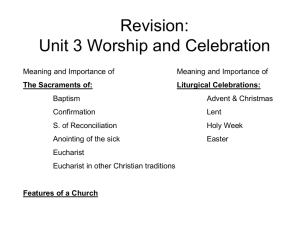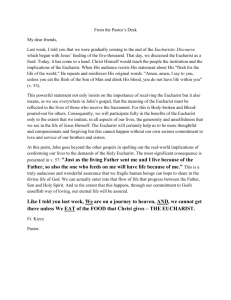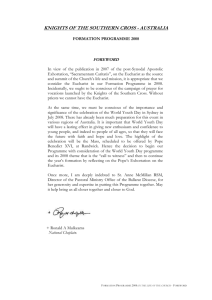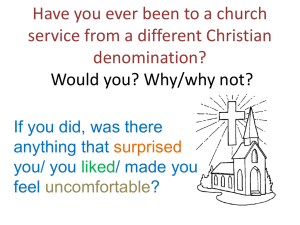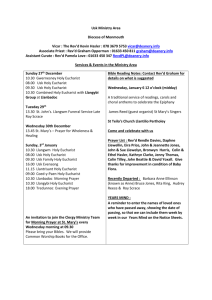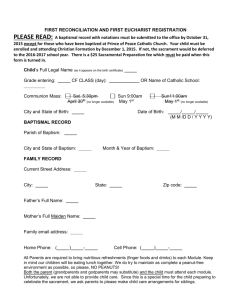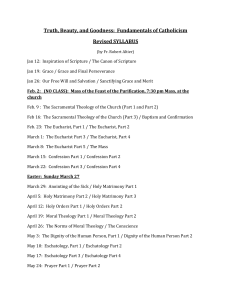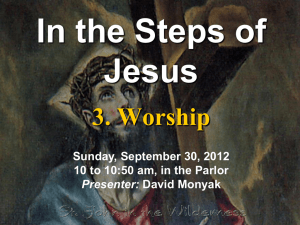Overheads - St. John in the Wilderness Church
advertisement
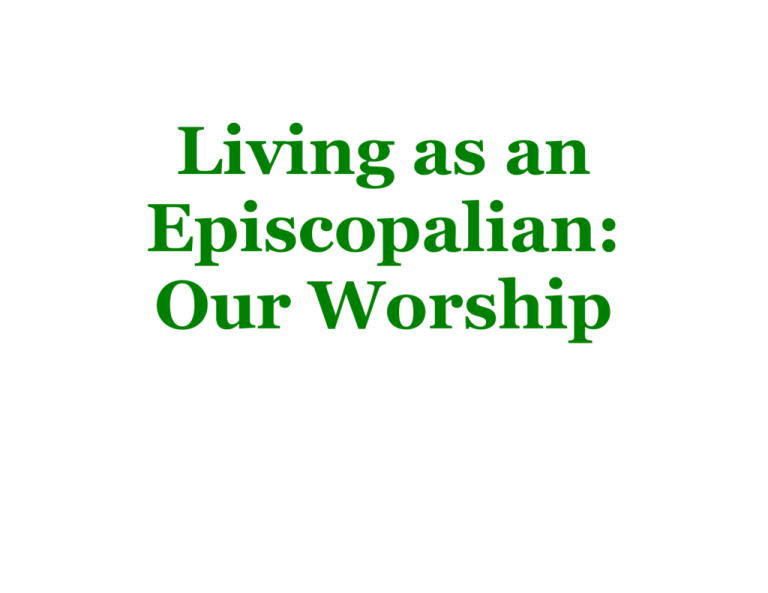
Living as an Episcopalian: Our Worship Living as an Episcopalian 1. History 2. Worship 3. The Church’s Teaching and the Bible 4. Spirituality 5. Ministry and Organization. The Mission of the Church Worship 1. What is Worship? 2. A Sacramental Universe. The Sacraments 3. The Eucharist 4. The Prayer Book 5. The Daily Office What is Worship? What is Worship? Webster’s: - reverence (profound, adoring, awed respect) offered to God - the act of expressing such reverence What is Worship? God: personal the Creator holy, unknowable, infinite the Alpha and the Omega “I AM who I AM” worship: our reverent response to the personal, holy, unknowable, infinite God What is Worship? “Thou hast made us for thyself, and our hearts are restless till they find their rest in thee.” - St. Augustine of Hippo (b. 354) rooted in our: - sense of the mystery of existence - desire for transcendence, meaning - sense of beauty - love - human needs, fears, joys What is Worship? can involve language, music, art, dance, all the senses - the Eastern Orthodox Divine Liturgy to a Quaker meeting may be corporate or private locations: Gothic cathedral to private home involves both - receiving something from God - offering, giving something of ourselves to God A Sacramental Universe. The Sacraments A Sacramental Universe “Teach me, my God and King, in all things thee to see” - George Herbert, Anglican poet “Earth’s crammed with heaven, And every common bush afire with God; But only he who sees takes off his shoes, The rest sit round and plunk blackberries.” - Elizabeth Barrett Browning A Sacrament Universe “To me, the meanest flower that blows can give Thoughts that do often lie too deep for tears.” - William Wordsworth “Ever since the creation of the world his eternal power and divine nature, invisible though they are, have been understood and seen through the things he has made.” (NRSV) - St. Paul, Romans 1:20 A Sacramental Universe Duality of Experience: - we are embodied beings existing in a very material world - we can feel intimations of beauty, mystery, meaning through this material world (a bush, a flower, a sunset. . .) A Sacramental Universe a “sacramental” view of the universe links the two pieces of this duality: - the material world is good - the material world can be “door to the sacred” Sacramental Universe Fundamental basis material world is good: - created by God - in the Incarnation, God freely took on embodied existence, lived in space and time material world can be a door to the sacred: - God is both: - transcendent reality beyond the world he has made - immanent reality who dwells in this world and is active in it A Sacramental Universe sacraments, rites there are many “sacraments:” material objects, or physical events/actions that can be “doors” to the sacred we have many “rites” = ritual physical actions, that express and are “doors” to feelings, inner realities, meaning beyond the mechanics of the act: - touching, embracing another person - making love - sharing a meal together - giving a gift - gestures of hospitality and welcome A Sacramental Universe Sacraments Church has defined seven “sacramental” rites or rituals: “Sacraments” two Sacraments of the Gospel: - Baptism - Holy Eucharist other Sacramental Rites that evolved under guidance of the Holy Spirit: - Confirmation - Ordination - Holy Matrimony - Reconciliation of a Penitent (Confession) - Unction (Anointing of the Sick) Sacraments 1. outward or visible part = “matter” and/or “form.” - the material object and/or physical action that is the “door” or “portal” to the sacred - Catechism: “the outward and visible signs” 2. inward spiritual reality = “res” - heart of the sacrament - the action of God on the human spirit - Catechism: “the inward and spiritual grace” The Eucharist The Holy Eucharist the “supreme” sacrament other names: - Lord’s Supper - Holy Communion - Divine Liturgy - the Mass - the Great Offering Christ is the - founder of the Sacrament - minister of the Sacrament - the supreme example of the grace bestowed by the Sacrament The Holy Eucharist 1. “matter” and/or “form” - matter: bread and wine - form: “four-fold” shape of the Eucharist - Jesus took bread - blessed it - broke it, - and distributed it 2. “res” - Richness of the Eucharist makes it almost impossible to name a specific grace. “Body and Blood of Christ given to his people” - self-giving The Holy Eucharist Facets 1. as a meal 2. as the real presence of Jesus 3. as a remembrance of the sacrifice of Jesus The Holy Eucharist as a Meal original setting in a Jewish meal Jewish beraka (blessing or thanksgiving) before meal: - host takes small loaf of bread - “Blessed are you, Lord God of the universe, you bring forth bread from the earth.” - host breaks bread and distributes it after meal: - host takes cup of wine - “Blessed are you, Lord God of the universe, you create the fruit of the vine.” - passes cup round the guests The Holy Eucharist as a Meal in Israel and ancient world: meal not merely an occasion for eating, drinking, but a sacred occasion in ancient church, the Eucharist began as a regular meal; then gradually became a symbolic meal The Holy Eucharist as Meal problems with Eucharist as regular meal: I Cor 11: “I do not commend you, because when you come together, it is not for the better, but for the worse . . . it is not the Lord’s Supper that you eat. For in eating, each one goes ahead with his own meal, and one is hungry and another is drunk.” Jude 1:12: “These are blemishes on your love feasts, as they boldly carouse together, looking after themselves.” The Holy Eucharist as Meal Summary as a meal, Eucharist includes: - table fellowship - praise and thanksgiving for God’s blessings to us - foretaste of the “feast to come” The Holy Eucharist as the Real Presence of Jesus “That which you see is bread and the cup, which even your eyes declare to you; but as to that in which your faith demands instruction, the bread is the body of Christ, the cup is the blood of Christ. . . these things are called sacraments for this reason, that in them one thing is seen, another thing is understood.” - St. Augustine of Hippo (b. 354) The Holy Eucharist as the Real Presence of Jesus Transubstantiation based on Greek view of reality. Every “thing” has: - a physical being detectable by our senses: “accidents” - metaphysical reality: “substance” “substance” of bread and wine is changed into the body and blood of Christ; “accidents” remain, still genuinely there The Holy Eucharist as the Real Presence of Jesus Summary in the material objects (the “matter”) of bread and wine), a “door” is open to us and we truly receive Jesus the “how” is a mystery and a continued matter for theological speculation Holy Eucharist as Sacrifice Last Supper likely a Passover meal, a sacrificial feast. - Jesus’ the paschal lamb of the new covenant Mark 10:45: “For the Son of Man came not be served but to serve, and to give his life a ransom for many.” Mark 14:24: “This is my blood of the covenant, which is poured out for many.” “Do this in remembrance of me” Holy Eucharist as Sacrifice Jesus’ death on Calvary unique and sufficient sacrifice - Reformers accused Roman Catholic Church of teaching Eucharist is a repetition of sacrifice of Calvary Do this in “remembrance” of me - remembrance = Greek anamnesis - not a mere remembering but a “representing:” a “past” event recalled and experienced so that its significance and power are known and felt as if the event were present Holy Eucharist as Sacrifice “re-presenting” of Calvary not merely a psychological “trick,” but recognition of a metaphysical reality: - event of Calvary not only a historical reality in space-time, but also “slain from the foundation of the world” (Rev 13:8) - all moments of space-time eternally present to God Holy Eucharist Summary 1. table fellowship of thanksgiving and praise 2. “sacramental” door to communion with Christ 3. re-presenting of Jesus’ sacrifice on Calvary, acknowledging that sacrifice as eternally “present” to God The Prayer Book The Prayer Book central to the Episcopal church other denominations have theologians: - Lutherans -- Luther - Reformed Churches -- Calvin - Roman Catholic Church -- Thomas Aquinas (Pope in 1879 declared Thomism eternally valid) The Prayer Book 1549: first Prayer Book - largely work of Archbishop of Canterbury Thomas Cranmer each Anglican Church has its own Prayer Book The Prayer Book The Daily Office (p. 37) The Great Litany (p. 148) The Collects: Traditional (p. 159) The Collects: Contemporary (p. 211) Proper Liturgies for Special Days (p. 264) Holy Baptism (p. 299) Holy Eucharist (p. 316) Pastoral Offices (p. 413) Episcopal Services (p. 511) The Psalters or Psalms of David (p. 585) Prayers and Thanksgiving (p. 810) An Outline of Faith or Catechism (p. 845) Historical Documents of the Church (p. 864) Tables for Finding the Date of Easter (p. 880) The Lectionary (p. 888) Daily Office Lectionary (p. 934) The Daily Offices The “Daily Offices” Medieval Monasticism in the West: “offices” of prayer: - Nocturns - Lauds - Prime - Terce and sung mass - Sext - None - Vespers - Compline The “Daily Offices” First Prayer Book tried to make prayer part of daily life with two “offices” of prayer: morning and evening 1979 Prayer Books, short (< 5 minutes) prayers for: - morning - noonday - early evening - evening reflects biblical image of church as a people of prayer

